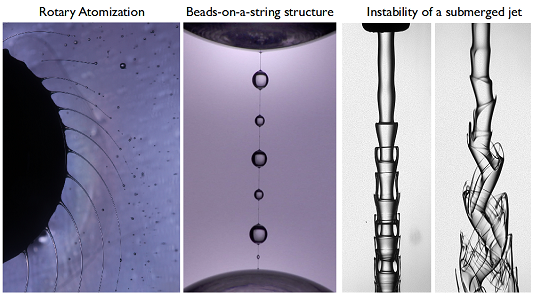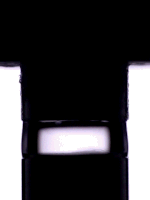Non-Linear Dynamics of Complex Liquids and Gels in Fragmentation/Fracture
Bavand Keshavarz
Many industrial and biological applications involve fracture or fragmentation of soft matter. Atomization of paint, disintegration of bio-fluids during coughing or sneezing, break up of ink drops or jets in 3D printers, spray of anti-misting fuel agents in airplane engines, and fracture of soft gels used in food industry are a few examples in which a micro-structured liquid or gel goes through fast, non-linear deformations. These complex liquids or gel networks show interesting rheological behavior, which affects the corresponding material response in fracture or fragmentation.
Polymeric liquids are known for pronounced extensional thickening in elongational flows, and the enhanced resistance against capillary breakup can affect their performance in fragmentation processes such as air spraying. Polymer networks can form gels that are used in variety of applications. One interesting example is a class of protein gels known as Casein gels, which are widely used in many food products. I, together with my colleagues in France (Thibaut Divoux and Sébastien Manneville), study the linear rheology of these gels at different concentrations. These gels are similar to a critical gel even many hours after gelation. We have performed in-situ rheology and modeled their behavior uing a simple fractional model. Electronic and confocal microscopy of the network combined with precise rheological measurements help us to find connections between the fractional models and the physical properties of the underlying network.

Figure 1. Fractal networks in Casein gels lead to a power law response in the macroscopic response.
We also study the nonlinear behavior of Casein gels and their fracture under different deformation protocols. For these model protein gels, I try to understand the effect of linear and nonlinear rheology on fracture dynamics.
The effect of underlying microstructure on different hydrodynamic instabilities is still unknown for many different complex fluids and flows. I am particularly interested in instabilities that evolve in interfacial phenomena such as atomization by air or centrifugal forces (shear-induced waves and Rayleigh-Taylor instability), and jet and filament breakup (Rayleigh-Plateau instability).

Figure 2. From Left: Rotary atomization is captured by a high-speed air-gap flash in less than 300 ns exposure time. Viscous filaments leave the rotating cup due to centripetal acceleration. Middle: A viscoelastic filament forms a beads-on-a-string morphology before it breaks up. Right: A submerged Newtonian jet becomes unstable in a water tank. Sinuous and varicose modes emerge as the wavenumber of the instability changes. This inertial instability was first studied by Lord Rayleigh. © B. Keshavarz, MIT NNF.
Movies
Extensional Rheometry
  |
(Left) CaBER (Capillary Breakup Extensional Rheometry) showing Beads-on-a-string (BOAS) structure.
(Right) Jet breakup during ROJER (Rayleigh Ohnesorge Jet breakup Extensional Rheometry) of a visco-elastic polymer solution. |
Rotary atomization
Collision of viscous jets
Shear induced instabilities of submerged jets
Fog free glass (with Dr. Ken Park)
